
VNU Journal of Science: Mathematics – Physics, Vol. 41, No. 1 (2025) 105-115
105
Original Article
Robust Stability of Implicit Dynamic Equations
with Nabla Derivative on Time Scales
Nguyen Thu Ha*
Department of Science, Electric Power University, 235 Hoang Quoc Viet, Hanoi, Vietnam
Received 8th Januray 2025
Revised 6th February 2025; Accepted 10th March 2025
Abstract: In this work we studied the robust stability for implicit integro-dynamic equations on
time scales with nabla derivative, which is considered as a generation of differential algebraic
equations and implicit difference equations. We showed the reservation of exponential stability of
these equations under small Lipschitz perturbations.
Keywords: Implicit integro-dynamic equations, index 1, uniformly stability, time scale, Lipschitz
perturbations.
1. Introduction*
Implicit integro-dynamic equations have been extensively utilized in various disciplines, including
demography, materials science, and actuarial science, with the renewal equation playing a prominent
role in these applications [1-3]. Despite this, only a small fraction of such equations and systems can be
solved in an explicit manner. As a result, much of the academic focus has shifted towards devising
approaches to study the qualitative properties of solutions without directly solving them. One of the
primary difficulties in this type of analysis is evaluating the robust stability of these systems.
Previous research has addressed robust stability in singular difference equations and dynamic
equations on time scales [4, 5]. However, most of this work has been confined to systems that either
lack memory or have only finite memory. This highlights the necessity of further investigating the robust
stability of implicit integro-dynamic systems
0
( ) ( ) ( ) ( ) ( , ) ( ) ( )
t
t
A t x t B t x t K t s x s s f t
________
* Corresponding author.
E-mail address: thuha@epu.edu.vn
https//doi.org/10.25073/2588-1124/vnumap.4986

N.T. Ha et al. / VNU Journal of Science: Mathematics – Physics, Vol. 41, No. 1 (2025) 105-115
106
with
0
tt
and
( ), ( )AB
,
( , ), ( )Kf
are specified later.
We address the issue of stability preservation in this dynamic equation when subjected to small
perturbations. Given that the derivative of the state process
()xt
at any given time
t
depends on its entire
path
0
( ), x s t s t
, a more generalized version of the Gronwall-Bellman inequality is required to
establish an upper bound for the perturbations.
This paper is structured as follows: The next section delves into the solvability of implicit integro-
dynamic equations. In Section 4, we examine the conditions under which the uniform or exponential
stability of solutions to implicit integro-dynamic equations remains intact under small Lipschitz
perturbations. Finally, in the Appendixes, we provide a brief overview of fundamental concepts and
preliminary results related to time scales.
2. Solutions of Implicit Dynamic Equations with Nabla Derivative
Let T be a time scale (see A1, Appendixes) and
f
denote the nabla derivative for the function
()f
. Consider the linear implicit dynamic equations (IDE) on time scales
0
( ) ( ) ( ) ( ) ( , ) ( ) ( ),
t
t
A t x t B t x t K t s x s s f t
(1)
where
( ), ( )AB
are two continuous functions defined on
0
t
, valued in the set of
nn
-matrices,
0
(),
loc n
pt
fL ¡
and
(.,.)K
be a two-variable continuous function defined on
0
( , ) : ,t s t s t
valued in
nn
¡
.
Suppose that
ker ( )A
is smooth, i.e., there exists a continuously
-differentiable projector
()Qt
onto
ker ( )At
and
2
QQ
,
( ) ker ( )ImQ t A t
for all
0
t
t
. By setting P=I-Q we can rewrite the equation
(1) as
0
( ) ( ) ( ) ( ) ( , ) ( ) ( ),
t
t
A t Px t B t x t K t s x s s f t
(2)
where
:B B A P
. It is seen that the solution
()x
of the equation (2), if it exists, is not necessarily
differentiable but it is required that the component
()Px
is
-differentiable almost everywhere on
0.
t
Consider the space
0
1
C ( ); n
A t
¡
being the set of
0);( n
t
yC ¡
such that
()Py
is almost everywhere-
differentiable on
0
t
. Define the linear operators
:.G A BQ
It is clear that
0;.()
loc n n
t
GL
¡
Definition 2.1 The IDE (1) is said to be index-1 if
()Gt
is invertible for all
0
t
t
. For any
0
T t
,
consider two subspaces:
1
1
00
([ , ); ) { ([ , ); ) : ( ) ( )},
Im
nn
QG
C t T v C t T v t QG t
¡¡
00
([ , ); ) { ([ , ); ) : ( ) ( )}.
Im
nn
P
C t T u C t T u t P t ¡¡
Lemma 2.2 Let S be a function defined on
00
[ , ] [ , ];
()
n
P
t T C t T¡
, valued in
n
¡
, such that
( , )S t y
depends only the values of
u
on
0
[ , ]tt
for every
0
()[ , ]; n
P
y C t T¡
and satisfies the Lipschitz
condition, i.e., there is a constant
0k
such that
0
1 2 1 2 0 1 2 0
, ( ).( , ) ( , ) sup ( ) ( ) [ , ], , [ , ]; n
P
t s t
S t y S t y k y s y s t t T y y C t T
¡

N.T. Ha et al. / VNU Journal of Science: Mathematics – Physics, Vol. 41, No. 1 (2025) 105-115
107
Then, the equation
11
( ) ( , ),y P PG B y PG S t y
with the initial condition
0 0 0
( ) ( )y t P t x
has a
unique solution in
0)[ , ]( ; n
P
C t T ¡
. Moreover, there exists a constant c such that if y(t) and z(t) are two
solutions of above equation then
00
( ) ( ) ( ) ( ) .y t z t c y t z t
The proof of this lemma can be easily obtained by using Picard's approximation method and usual
procedures. In the next step, we will use above lemma for the proof of next theorem.
Theorem 2.3 For any
00t
and
0 n
x¡
, the equation (2) has a unique solution
0
1()( ) ; n
At
x ¡
,
with the initial condition
0 0 0
( ) ( ) 0P t x t x
. (3)
Proof i) Let
( ) ( )u Px
and
( ) ( ).v Qx
Multiplying both sides of (2) with
11
,PG QG
and using
Lemma A.3.2 we obtain
0
1 1 1
( ) ( ) ( ) ( ) ( , ) ( ) ( ) ,
( ) ( )
t
t
u t P PG B t u t PG f t PG K t s u s v s s
(4)
0
1 1 1
0
( ) ( ) ( ) ( , ) ( ) .( ) ,
()
t
t
v t QG Bu t QG f t QG K t s u s v s s for t t
(5)
ii) Consider the operator
00
: [ , ); [ , );
nn
H C t C t ¡¡
defined by
0
1
( )( ) ( ) ( , ) ( ) .
t
t
Hv t v t QG K t s v s s
Follows from Theorem 3.1[1] and the continuity of
1( ) (.,.)QG K
, it implies the invertibility of H
because
0
( )( ) ( ), Hv t y t t t
is a Volterra integral equation of second kind. Precisely,
0
1
1
( )( ) ( ) ( , ) ( )
t
n
t
n
H y t y t tU s y s s
where,
n
U
is defined by induction
11
11
( , ) ( ) ( , ), ( , ) ( , ) ( ) ( , ) ,
t
nn
s
t s QG t K t s U t sU t QG K sU
for
0,1t s t n
. On the other hand, for any
0
Tt
we have
00
10
()
sup ( , ) sup ( ) ( , ) .
!
nn
n
t s t T t s t T
Tt
t s QU G t K t s n
(6)
This implies that the series
1
( , )
n
n
I t sU
is uniformly convergent on the set
0
( , ): t s t s t T
and
1
( , ) ( , )
n
n
R t s I U ts
is a continuous funtion. Thus,
1
H
is also a second kind linear Volterra
operator with the kernel
(.,.)R
. This means that
H
is a continuous bijection on
0
[ , ]; n
C t T ¡
. Then,
the equation (5) can be rewritten
0
1 1 1 1
1 1 1 1 1
( ) ( , ) ( ) ( ) ( )( )
( ) ( )( ) ( ) ( )( ),
[]
t
v t H QG Bu K s u s s t H QG f t
H QG Bu t H u t u t H QG f t
or
1 1 1
ˆ
( ) ( )( ) ( ) ( )( ),v t H Pu t u t H Q G f t
(7)
where
1
ˆˆ
Q I P QG B
is the canonical projector onto
ker A
.

N.T. Ha et al. / VNU Journal of Science: Mathematics – Physics, Vol. 41, No. 1 (2025) 105-115
108
iii) Combining (7) with (4), we obtain
0
1 1 1 1 1
0
ˆ
( ) ( ) .(( ) ( ) ( , ) )( ) ,
t
t
u t P PG B u t PG f t PG K t s H Pu QG f s s t t
(8)
By using Lemma 2.2, we see that the equation (8) has a unique solution
()u
with initial condition
0 0 0
( ) ( )u t P t x
. Then, we use the formula (7) to obtain the solution of (2) as
1 1 1
ˆ
( ) ( ) ( ) ( )( ) ( )( ),x t u t v t H Pu t H QG f t
(9)
for
0
tt
. The proof is complete.
W
Remark 2.4 i) Follow the above decoupling procedure, we state the initial condition
0 0 0
( ) ( )u t P t x
,
or equivalent to
0 0 0 0
( ) ( ) 0 , n
P t x t x x ¡
. (10)
We note that the above condition does not depend on the chosen projector opertor
0
()Qt
.
ii) Let u(t) be the solution of the equation (8). Then we have
Q u Q P u
. Furthermore,
2
()Q Q Q Q Q Q
which implies
( ) .Qu Q u Q u Q QuQP Q Q u Q Quu
Thus, if
00
( ) ( ) 0Q t u t
then
( ) ( ) 0Q t u t
, for all
0
tt
. This means that (8) has the invariant property:
every solution starting in
0
Im ()Pt
remains in
0
Im ()Pt
for all
00
)
I
( ) (
m
x t P t
then
)
I
( ) (
m
x t P t
,
for all
0
t
t
.
iii) Since
1
QG
is independent of the choice of
Q
, so is the operator H and
10
([ , ]; )
n
QG
C t T
¡
is
independent of the choice
Q
and the space
10
([ , ]; )
n
QG
C t T
¡
is invariant under the the operator H.
Next, we try to give the variation of constants formula for the solution of equation (2). Consider the
homogeneous equation
0
( ) ( ) ( , ) ( ) .
t
t
A Px t Bx t K t s x s s
(11)
Define by
0
( , ), t s t s t
the Cauchy matrix generated by homogeneous system (11) as the
solution of the equation
( ) ( , ) ( ) ( , ) ( , ) ( , ) ,
t
s
A t t s B t t s K t s
(12)
and
( ) ( , ) 0P s s s I
. Then, we have the variation of constants formula for the solution of (2).
Theorem 2.5 The solution
()x
of the equation (2) with the initial condition
0 0 0
( ) ( ) 0P t x t x
can be
expressed as
00
1 1 1 1 1
0 0 0
( ) ( , ) ( ) ( , ) ( ) ( ) ( , )( )( ) ( )( ), (13)
t
tt
x t t t P t x t PG f K h H QG f h h H QG f t
for all
0.tt
Proof A similar procedure to split the solution of the equation (10) into
( ) ( ) ( )y u v
obtains
0
1 1 1 ˆ
( ) ( ) ( , ) ( ) ,
( ) ( )
t
t
t
u t P PG B u t PG K t s H P u s s
and
1ˆ
( ) ( )( ).y t H P u t
(14)
Denote by
0(.,.)
the Cauchy operator of (13), i.e., it is the solution of the matrix equation
1 1 1
0 0 0
ˆ
( , ) ( , ) ( ) ( , ) ( , ) ( )
( ) ( )
t
s
t s P PG B t s PG t K t H P s

N.T. Ha et al. / VNU Journal of Science: Mathematics – Physics, Vol. 41, No. 1 (2025) 105-115
109
and
00
( , ) , .s s I t s t
Then, by directly differentiating both sides we obtain the variation constants
formula for the solution
()u
of (8) with the initial condition
0 0 0
u t P t x
,
0
0
1 1 1
0 0 0 0 0
( ) ( , ) ( ) ( , ) ( ) ( , ) ( ) .
()
t
t
t
u t t t P t x t PG f K h H QG f h h
(15)
On the other hand, since
0 0 0 0
( ) ( , ) ( )u t t t P t x
and by (14) we have the relation between
( , )ts
and
1
0
ˆ
( , ) ( , ) ( ) ( ).
()
t s H P s P s t
(16)
By acting
1ˆ
HP
to both sides of (15) and paying attention to the expression (9) it is seen that the unique
solution
()x
of (2) with the condition
0 0 0
( ) ( ) 0P t x t x
can be given by the formula (13). The proof
is complete.
W
Assumption 1 There exists a differentiable projector
()Q
onto
ker ( )A
such that
1
QG
and
P
are
bounded on
0
t
.
Definition 2.6 i) The IDE (11) is uniformly stable if there exists a constant
00M
such that
0
( , ) , .t s M t s
ii) Let
. The integro - equation (11) is said to be
exponentially stable if there exists a constant
0M
such that
( , ) ( , ), .t s Me t s t s
In the next section, we consider the effect of small nonlinear perturbations to the stability of IDE (11).
3. Robust Stability of Implicit Dynamic Equation with Nabla Derivative
Consider the perturbed equation of the form
0
0
( ) ( ) ( ) ( ) ( , ) ( ) ( , ( )), .
t
t
t
A t x t B t x t K t s x s s F t x t t
(17)
Assume that
( ,0) 0Ft
for all
0,tt
which follows that the equation (17) has the trivial solution
( ) 0x
. First at all, we consider the solvability of (17).
Assumption 2 For all
0,tt
the functions
1( ) ( , )PG t F t x
and
1( ) ( , )QG t F t x
are Lipschitz in x with
Lipschitz coefficient
t
l
and
t
, respectively. Suppose further that
l
and
are continuous functions.
We endow
10
([ , ]; )
n
QG
C t T
¡
with the norm inherited from
0
([ , ]; )
n
C t T ¡
and understand that
1
H
mean that the norm of operator
1
H
in
10
([ , ]; )
n
QG
C t T
¡
. By denoting
0
sup
ts
t s t
for
0
tt
, we have
Lemma 3.1 Let
0
Tt
. If
11
TH
, then the equation (17) with the initial condition
0 0 0
( ) ( ) 0P t x t x
is solvable on
0
[,]tT
. Further, there exists a constant
T
M
such that
0 0 0
( ) ( ) ( ) , for all .
T
x t M P t x t t t T
Proof Put
( ) ( )u Px
and
( ) ( )v Qx
, for
0
T t t
we have
0
1 1 1 1 1
ˆ
( ) ( ) ( ) ( , ) )( ) , ( ) .(
t
t
u t P PG B u t PG K t s H Pu QG f s s PG F t x t
(18)

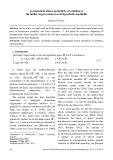



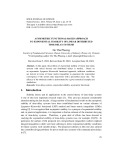
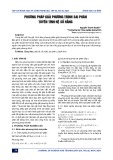
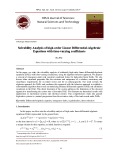
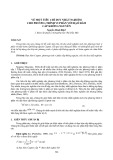
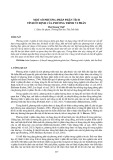










![Bộ câu hỏi lý thuyết Vật lý đại cương 2 [chuẩn nhất/mới nhất]](https://cdn.tailieu.vn/images/document/thumbnail/2025/20251003/kimphuong1001/135x160/74511759476041.jpg)
![Bài giảng Vật lý đại cương Chương 4 Học viện Kỹ thuật mật mã [Chuẩn SEO]](https://cdn.tailieu.vn/images/document/thumbnail/2025/20250925/kimphuong1001/135x160/46461758790667.jpg)




